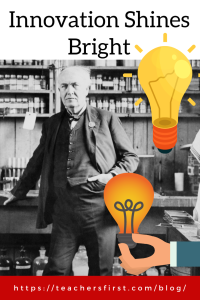“I have not failed. I’ve just found 10,000 ways that won’t work.”
– Thomas A. Edison
As teachers, we strive to invent and implement engaging classroom experiences only to feel compelled to change and tweak them the following year to meet the needs of our new cadre of students. It’s challenging to reinvent classroom experiences, but we continue to iterate and take risks for our students. Sometimes we are successful, and sometimes we fail.
Nevertheless, we channel our inner Thomas Edison and keep trying, thus establishing a culture of innovation and creativity in the classroom. In the 1870s, many inventors were working on creating lighting devices. Yet, on December 31, 1879, after years of work and thousands of experiments, Thomas Edison gave the first public demonstration of the incandescent electric light bulb at his laboratory in Menlo Park, New Jersey. The electric light bulb and Edison’s process of creating it were both innovative. For example, Edison pulled together a cross-functional team of scientists, engineers, and machinists. Edison and his team also proved failure provides a path to learning, and they practiced a growth mindset before Carol Dweck made it a schoolwide term! Thomas Edison didn’t stop after improving the light bulb. He also continued developing inventions that made using light bulbs practical. As a result, teachers and students can use the same processes that helped Edison succeed.
There are myriad ways to make a classroom innovative and emulate Thomas Edison. Innovation is about connecting with your students through critical thinking experiences. If we’re innovating, we’re growing.
Project-Based Learning (PBL)
Project-based learning is an active learning strategy to help students take ownership of their learning. First, learn what PBL is, what it isn’t, and how to get started in this blog post. Project-based learning relies on developing key skill sets such as research, critical thinking, problem-solving, and collaboration. Then, explore our TeachersFirst’s collection of project-based learning resources that encourage students to gain knowledge by working actively exploring problems and investigating authentic and complex questions or challenges. PBL may help light your student’s love for learning!
Makerspaces
Makerspace activities also foster innovation in the classroom. They support a culture of creativity, problem-solving, collaboration, reflection, and perseverance and embrace risk-taking. You’ll find great ideas and activities in this TeachersFirst collection on actively engaging your students with makerspaces. Also, in a 2014 NPR podcast, Neil Degrasse Tyson said our early space missions didn’t just land a man on the moon. They inspired a whole generation. Tyson explains, “Bill Gates and Steve Jobs were 13 and 14 when we landed on the moon. Those are ripe ages to want to invent something new. Just look at that influence from that era.” The skills our students gain through makerspace activities will transfer to future problem-solving opportunities they face in their careers and life. Additionally, these activities can create meaningful experiences that support our diverse student populations and allow for cultural inclusion.
Design Thinking
Design thinking is a process that anchors innovative activities in your classroom. Learn more about design thinking basics and the steps in the process you can incorporate in your classroom from this blog post we shared. Design thinking gives our students the tools to become innovative thinkers and uncover creative opportunities. Teachers can also use design thinking to simplify processes and improve student experiences. It also minimizes risk and provides a framework for complex, student-centered challenges.
Thomas Edison may be best known for his work with the incandescent light bulb, but his brightest influence was fostering a culture of innovation. We would love to hear about your ideas and strategies to foster innovation in your classroom in the comments below!



I really enjoyed this article because each year I am always looking for ways to make my ENL classroom more innovative. I love Project Based Learning because students can take ownership of their learning and use skills such as research, critical thinking problem solving and can work together. I love the idea of makerspaces to support creativity, problem solving, collaboration, reflection and risk taking. These are all very important skills for ELLs to learn and they can use each other as support depending on proficiency levels. This goes for Design Thinking as well because students can uncover creative opportunities with minimal risk and a framework that is helpful for ELLs when learning the language and expressing themselves. I find that these types of activities keep students more engaged and the work is so much more relatable and meaningful.